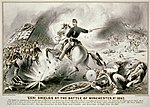Glen Burnie (Winchester, Virginia)
1794 establishments in VirginiaGeorgian architecture in VirginiaHistoric American Buildings Survey in VirginiaHouses completed in 1794Houses in Winchester, Virginia ... and 3 more
Houses on the National Register of Historic Places in VirginiaNational Register of Historic Places in Winchester, VirginiaShenandoah Valley, Virginia Registered Historic Place stubs

Glen Burnie is a historic home located at Winchester, Virginia. It consists of a 2+1⁄2-story central section built in two sections about 1794, with flanking two-bay, two-story wings built in 1959. It is a brick dwelling in the Georgian style.Built in 1794 by Robert Wood, son of James and Mary Wood. James founded Frederick Town (later Winchester) in 1744.It was added to the National Register of Historic Places in 1979.The house is now part of the Museum of the Shenandoah Valley.
Excerpt from the Wikipedia article Glen Burnie (Winchester, Virginia) (License: CC BY-SA 3.0, Authors, Images).Glen Burnie (Winchester, Virginia)
Amherst Street, Winchester
Geographical coordinates (GPS) Address External links Nearby Places Show on map
Geographical coordinates (GPS)
| Latitude | Longitude |
|---|---|
| N 39.186944444444 ° | E -78.178611111111 ° |
Address
Glen Burnie
Amherst Street
22601 Winchester
Virginia, United States
Open on Google Maps











